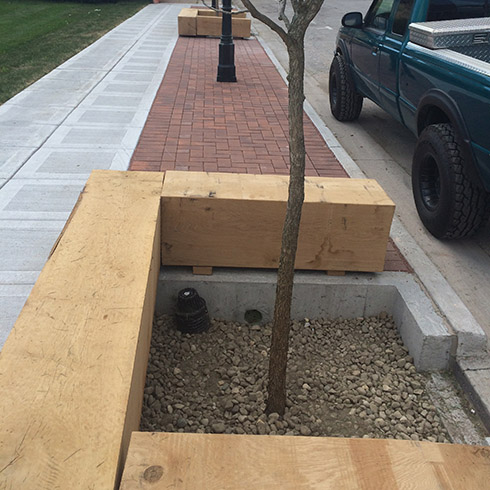Trees function as natural stormwater control systems. Their canopies capture rainfall, allowing a portion of it to evaporate before it ever reaches the ground. Through a process called evapotranspiration, trees pull moisture from the soil and release it back into the atmosphere. Their roots improve soil structure and infiltration, allowing rainwater to soak into the ground more effectively. In the process, trees absorb nutrients like nitrogen and phosphorus that might otherwise pollute local waterways. The presence of trees also helps prevent erosion, as their foliage softens the impact of rainfall and their roots help stabilize the soil.
Tree boxes and tree trenches are green infrastructure practices that integrate trees into urban stormwater management. Tree boxes are compact and feature a single tree planted in engineered soil within a structural container, often along streets or sidewalks. These systems include underdrains and overflow connections that tie into the storm sewer, making them ideal for space-limited sites. Tree trenches, by contrast, are larger, linear systems that provide a continuous volume of engineered soil beneath permeable pavement. They allow tree roots to expand horizontally and improve both tree health and stormwater performance. Both systems reduce runoff, filter pollutants, and support healthy urban canopies while making efficient use of built environments.
Recent research and design guidelines suggest that tree boxes and tree trenches should ideally have open-bottom designs to allow for infiltration into the underlying soil and support healthy tree growth. However, in areas where infiltration is not desirable or feasible closed-bottom designs may be necessary.
Key components
Tree chamber: The planting area that holds the tree and engineered soil, designed to support root growth and pollutant removal.
Inlet structure: Directs stormwater from surrounding impervious surfaces into the system, typically through curb cuts, trench drains, or permeable pavers.
Engineered soil media: A specially blended soil that promotes infiltration, supports tree health, and filters pollutants.
Underdrain system: A perforated pipe beneath the soil that carries excess water to the storm sewer if it cannot infiltrate.
Overflow structure: Safely conveys water away when the system exceeds its design capacity, protecting the surrounding infrastructure.
Structural support system: In tree boxes, a container defines the system’s limits. In tree trenches, structural soil cells or suspended pavement prevent soil compaction and allow roots to grow under paved areas.
Surface cover: May include mulch (tree boxes) or permeable pavement (tree trenches) to allow stormwater to enter the system while supporting traffic or foot use.


